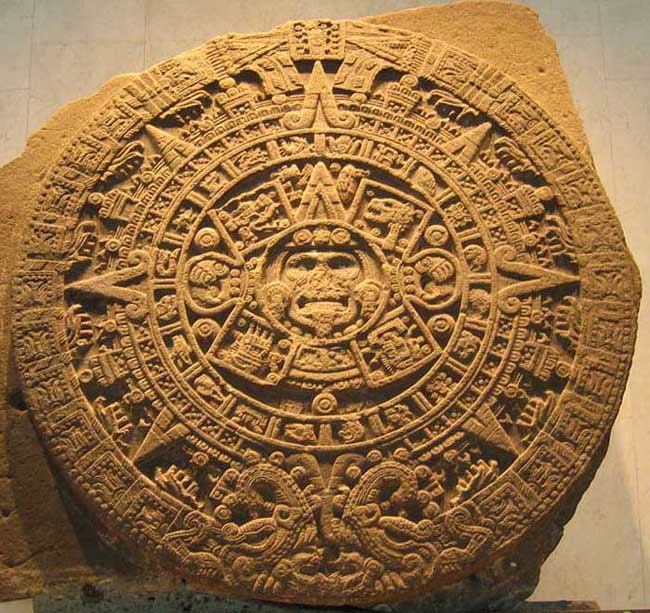
Sun Stone

Sun Stone
The Aztec calendar is the calendar system that was used by the Aztecs as well as other Pre-Columbian peoples of central Mexico. It is one of the Mesoamerican calendars, sharing the basic structure of calendars from throughout ancient Mesoamerica.
The calendar consisted of a 365-day calendar cycle called xiuhpohualli (year count) and a 260-day ritual cycle called tonalpohualli (day count). These two cycles together formed a 52-year "century," sometimes called the "calendar round". The xiuhpohualli is considered to be the agricultural calendar, since it is based on the sun, and the tonalpohualli is considered to be the sacred calendar.
The calendric year may have begun at some point in the distant past with the first appearance of the Pleiades (Tianquiztli) asterism in the east immediately before the dawn light. But due to the precession of the Earth's axis, it fell out of favor to a more constant reference point such as a solstice or equinox. Early Spanish chroniclers recorded it being celebrated in proximity with the Spring equinox.
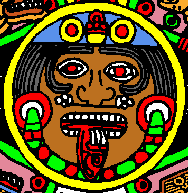
Tonatiuh's Face is the face of the sun, Lord of Heaven, around which takes place all daily and periodic phenomena. The crown, nose-pendant, ear-rings and necklace are magnificent, as must be the ornaments characteristic of this deity. The hair is blond, due to the golden appearance of the sun. The wrinkles on the face show age and maturity. And the tongue, stuck out is the form of an obsidian knife, indicates that the diety demands to be fed with blood and human hearts.
First Ring - from Center. Four Olin representing the Earthquake Epoch or Sun. The four epochs represented inside the square portions of this symbol correspond to the four previous epochs also called suns.
Second Ring - The second ring from the center is composed of 20 named days contained in one month, also used for naming years. Each year starts on one of four of these 20 days.

Third Ring - Sun Rays - Chalchihuite Ornaments - Splashed Blood Symbols
Outer Ring - Dedication Plate - Herbs with Buds - White Scrolls - Flame Sign - Xiucoatl's Tail
The tonalpohualli (count of days) was the sacred almanac of the Mexicas. This ritual calendar was registered in the tonalamatl (book of days), a green-fold bark paper or deerskin codex from which a priest (called tonalpouque) cast horoscopes and predicated favorable and unfavorable days of the cycle.
The almanac year comprised of 260 days, each of which was assigned a date by intermeshing one of 20 day-signs, represented graphically with a glyph, and a number from 1 to13, represented by dots so that no two days in the cycle could be confused. The almanac year was thus made up of 20 13-day weeks, with the first week beginning on 1-Crocodile and ending on 13-Reed, the second week running from 1-Ocelot to 13-Deaths' Head and so on. A god or goddess was believed to preside over each day-sign.
The set of day signs used in central Mexico is identical to that used by Mixtecs, and to a lesser degree similar to those of other Mesoamerican calendars. Each of the day signs also bears an association with one of the four cardinal directions.
There is some variation in the way the day signs were drawn or carved. Those here were taken from the Codex Magliabechiano. The Codex Magliabechiano is a pictorial Aztec codex created during the mid-16th century, in the early Spanish colonial period. It is representative of a set of codices known collectively as the Magliabechiano Group. Others in the group include the Codex Tudela and the Codex Ixtlilxochitl. The Codex Magliabechiano is primarily a religious document. Its 92 pages are almost a glossary of cosmological and religious elements. They depict in turn the 20 day-names of the tonalpohualli the 18 monthly feasts, and the 52-year cycle. They also show various deities, indigenous religious rites, costumes, and cosmological beliefs.
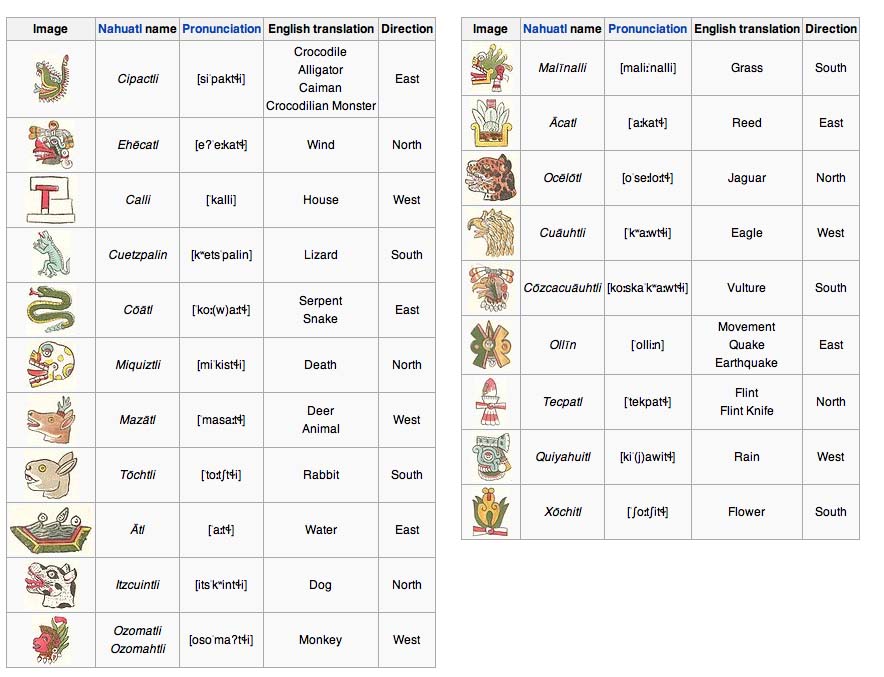
Wind and Rain are represented by images of their associated gods, Ehecatl and Tlaloc (respectively). Other marks on the stone showed the current world and also the worlds before this one. Each world was called a sun, and each sun had its own species of inhabitants. The Aztecs believed that they were in the fifth sun and like all of the suns before them they would also eventually perish due to their own imperfections. Every fifty two years was marked out because they believed that fifty two years was a life cycle and at the end of any given life cycle the gods could take away all that they have and destroy the world.
A set of thirteen numbered days is known by the Spanish term trecena (from trece "thirteen"). Each of the twenty trecenas in the 260-day cycle was associated with a particular deity:
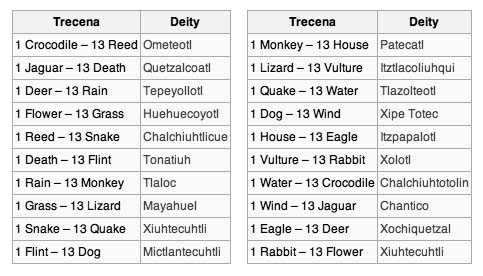
Xiuhpohualli is the Aztec year (xiuhitl) count (pohualli). One solar year consists of 360 named days and 5 nameless (nemontemi). These 'extra' days are thought to be unlucky. The year was broken into 18 periods of twenty days each, sometimes compared to the Julian month. The Aztec word for moon is metzli but whatever name that was used for these periods is unknown. The Mayan calendar has a similar configuration and the same 20-days period which they labeled uinal. Through Spanish usage, the 20 day period of the Aztec calendar has become commonly known as a veintena.
Each 20 days period started on Cipactli (Crocodile) for which a festival was held. The eighteen veintena are listed below. The dates are from early eye-witnesses. Each wrote what they saw. Bernardino de Sahagin's date precedes the observations of Diego Duran by several decades and is believed to be more recent to the surrender. Both are shown to emphasize the fact that the beginning of the Native new year became non-uniform as a result of an absence of the unifying force of Tenochtitlan after the Mexica defeat.
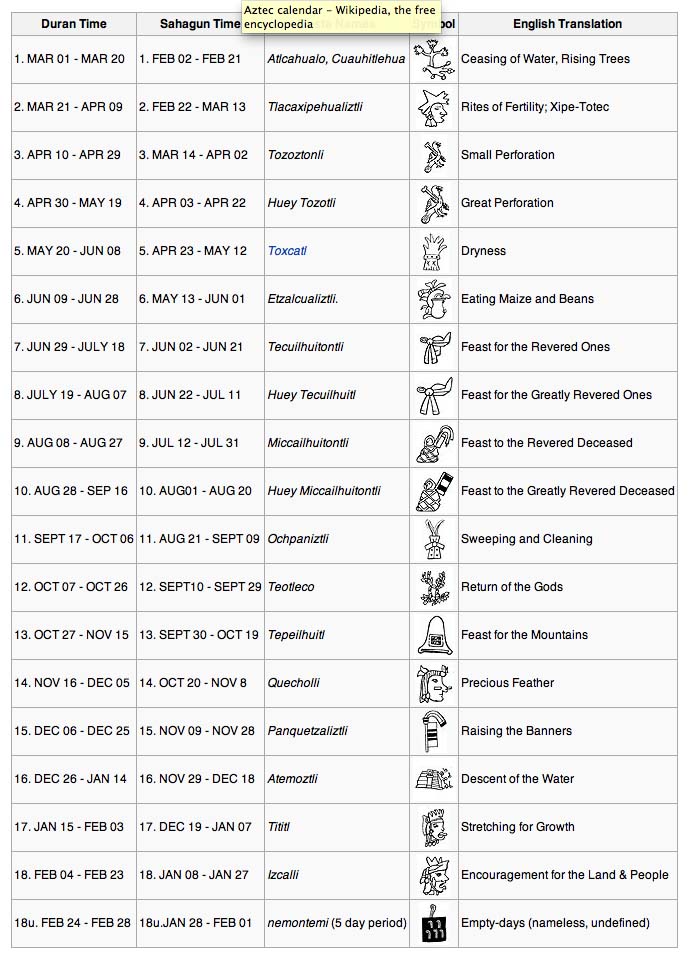
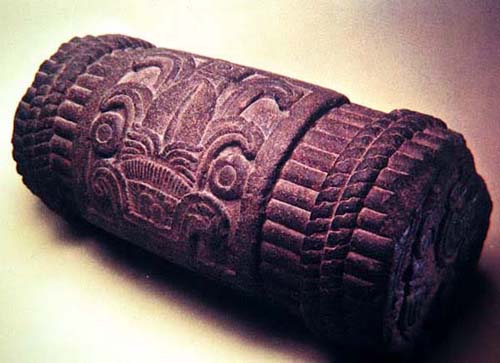
Aztec, Xiuhmolpilli, symbolic marks for completion 52 year cycle
Xiuhmolpilli commemorative sculpture marking the completion of the fifty-two-year cycle. Every 52 years the tonalpohualli and the xiuhpohualli calendars would align. This marked what was known as a Mesoamerican "century." Every one of these centuries was marked by xiuhmolpilli - Binding Up of the Years or the New Fire Ceremony. This was a festival that lasted 12 days and included fasting as a symbol of penitence. At the beginning of this festival all the lights in the city were extinguished - people let their hearth fires go out. Then on midnight of the 12th day of the festival, a prisoner was taken to the priest. The priest would watch in the night sky for the star of fire to reach the zenith. Once it did, the priest would remove the heart of this man, and replace it with a piece of wood, that was laid on a piece of turquoise. This is where the priest would start the new fire that would once again light the city.
The two calendars were was basically similar. The ritual day cycle was called Tonalpohualli and was formed, as was the Mayan Tzolkin, by the concurrence of a cycle of numerals 1 through 13 with a cycle of 20 day names, many of them similar to the day names of the Maya.
Where the Aztec differed most significantly from the Maya was in their more primitive number system and in their less precise way of recording dates. Normally, they noted only the day on which an event occurred and the name of the current year. This is ambiguous, since the same day, as designated in the way mentioned above, can occur twice in a year. Moreover, years of the same name recur at 52-year intervals, and Spanish colonial annals often disagree as to the length of time between two events.
Other discrepancies in the records are only partially explained by the fact that different towns started their year with different months. The most widely accepted correlation of the calendar of Tenochtitlan with the Christian Julian calendar is based on the entrance of Cortes into that city on November 8, 1519, and on the surrender of Cuauhtemoc on August 13, 1521. According to this correlation, the first date was a day 8 Wind, the ninth day of the month Quecholli, in a year 1 Reed, the 13th year of a cycle.
The Mexicans, as all other Meso-Americans, believed in the periodic destruction and re-creation of the world. The "Calendar Stone" in the Museo Nacional de Antropologia (National Museum of Anthropology) in Mexico City depicts in its central panel the date 4 Ollin (movement), on which they anticipated that their current world would be destroyed by earthquake, and within it the dates of previous holocausts: 4 Tiger, 4 Wind, 4 Rain, and 4 Water.
The Aztec calendar kept two different aspects of time; tonalpohualli and xiuhpohualli. Each of these systems had a different purpose. The tonalpohualliwas the 'counting of days.' It originated by ancient peoples observing that the sun, crossed a certain zenith point near the Mayan city of Copan, every 260 days. So this first system is arranged in a 260-day cycle. These 260 days were then broken up into 20 periods, with each period containing 13 days, called trecenas. Each period was given the name of something that was then shown by a hieroglyphic sign, and each trecena was given a number 1-13. Each trecena is also thought to have a god or deity presiding over each of the trecena. They kept these counts in tonalamatls, screenfold books made from bark paper. The Aztecs used this as a religious calendar. Priests used the calendar to determine luck days for such activities as sowing crops, building houses, and going to war.
The xiuhpohualli was the 'counting of the years.' This calendar was kept on a 365-day solar count. This was also the agricultural and ceremonial calendar of the Aztec state. It was divided into 18 periods, with each period containing 20 days, called veintenas. This left five days that were not represented. These were called "nemontemi." These were the five transition days between the old and the new year, and were considered days of nothing. This was a time of festivals. People came to the festivals with their best clothes on, and took part in singing and dancing. This is also when the priest would perform sacrifices, most of these sacrifices were human, but others were preformed on animals and fruit.
The solar year was the basis for the civil calendar by which the Mexicas (Aztecs) determined the myriad ceremonies and rituals linked to agricultural cycles. The calendar was made up of 18 months, each lasting 20 days. The months were divided into four five-day weeks. The year was rounded out to 365 days by the addition of the five-day nemontemi (empty days), an ominous period marked by the cessation of normal activities and general abstinence. The correlation of dates in the Gregorian calendar is uncertain, although most authors on the subject affix the beginning of the Aztec year to early February. A variety of sources were consulted in developing the following chart of some of the ritualistic activities associated with each month.
Many of the Aztecs' religious ceremonies, including frequent human sacrifices, were performed at the Great Temple, located in the center of their capital city of Tenochtitlan.